Organizational Life Cycle Sustainability Assessment (OLCSA) for a Higher Education Institution as an Organization: A Systematic Review and Bibliometric Analysis
Abstract
:1. Introduction
2. Materials and Methods
2.1. Planning and Preparing a REVIEW
- What is the current state of the art on OLCSA?
- What is the current research trend of SO-LCA based on bibliometric analysis?
- What are the suitable methods available in the related research?
2.2. Performing the Review
2.2.1. Systematic Literature Search
2.2.2. Bibliometric Analysis of OLCSA
2.3. Disseminating and Reporting the Results of the Review
3. Results
3.1. Subject Areas in OLCSA (O-LCA, E-LCC, and SO-LCA) Research
3.1.1. Organizational Life Cycle Sustainability Assessment Literature Review
3.1.2. Literature Found about Organizational Life Cycle Assessment (O-LCA) of University or Higher Education Institute
3.1.3. Literature Found about Social Organizational Life Cycle Assessment (SO-LCA) of University or Higher Education Institute
3.1.4. Literature Found about Environmental Life Cycle Costing (E-LCC) of University or Higher Education Institute
3.2. Visual Maps Based on Bibliometric Analysis
3.2.1. Co-Authorship
Author
Organization
Country Co-Authorship
3.2.2. Co-Occurrence of Keywords
All Keywords
Author Keywords
Index Keywords
3.2.3. Co-Citation
Cited Reference
Cited Source
Cited Author
4. Discussion
4.1. Method Used for O-LCA
4.2. The Method Used for SO-LCA
4.3. Methods Used for Organization Life Cycle Costing E-LCC or O-LCC
5. Conclusions
Author Contributions
Funding
Institutional Review Board Statement
Informed Consent Statement
Data Availability Statement
Acknowledgments
Conflicts of Interest
References
- Manzardo, A.; Loss, A.; Niero, M.; Vianello, C.; Scipioni, A. Organizational life cycle assessment: The introduction of the production allocation burden. In Procedia CIRP, Proceedings of the 25th CIRP Conference on Life Cycle Engineering (CIRP LCE), Copenhagen, Denmark, 30 April–2 May 2018; Laurant, A., Leclerc, A., Niero, M., Dong, Y., Olsen, S.I., Owsianiak, M., Bey, N., Ryberg, M., Hauschild, M.Z., Eds.; Elsevier: Amsterdam, The Netherlands, 2018; Volume 69, pp. 429–434. [Google Scholar]
- Omran, N.; Sharaai, A.; Hashim, A. Visualization of the sustainability level of crude palm oil production: A life cycle approach. Sustainability 2021, 13, 1607. [Google Scholar] [CrossRef]
- UNEP/SETAC. Guidance on Organizational Life Cycle Assessment; UNEP: Paris, France, 2015; ISBN 978-92-807-3453-9. [Google Scholar]
- I.S.O. TS 14072; Environmental Management—Life Cycle Assessment—Requirements and Guidelines for Organizational Life Cycle Assessment. International Organization for Standardization: Geneva, Switzerland, 2014.
- Martínez-Blanco, J.; Forin, S.; Finkbeiner, M. Launch of a new report: “Road testing organizational life cycle assessment around the world: Applications, experiences and lessons learned”. Int. J. Life Cycle Assess. 2018, 23, 159–163. [Google Scholar] [CrossRef]
- Lo-Iacono-Ferreira, V.G.; Torregrosa-López, J.I.; Capuz-Rizo, S.F. Organizational life cycle assessment: Suitability for higher education institutions with environmental management systems. Int. J. Life Cycle Assess. 2017, 22, 1928–1943. [Google Scholar] [CrossRef]
- Keeble, B.R. The Brundtland report: ‘Our common future’. Med. War 1988, 4, 17–25. [Google Scholar] [CrossRef]
- Soni, V.; Singh, S.P.; Banwet, D.K. Sustainable coal consumption and energy production in India using life cycle costing and real options analysis. Sustain. Prod. Consum. 2016, 6, 26–37. [Google Scholar] [CrossRef]
- ISO 14001; Environmental Management Systems—Requirements with Guidance for Use. ISO: Geneva, Switzerland, 2004.
- ISO 14044:2006; Environmental Management—Life Cycle Assessment—Requirements and Guidelines. ISO: Geneva, Switzerland, 2006.
- Finkbeiner, M.; Wiedemann, M.; Saur, K. A comprehensive approach towards product and organisation related environmental management tools. Int. J. Life Cycle Assess. 1998, 3, 169–178. [Google Scholar] [CrossRef]
- Martínez-Blanco, J.; Lehmann, A.; Chang, Y.-J.; Finkbeiner, M. Social organizational LCA (SOLCA)—A new approach for implementing social LCA. Int. J. Life Cycle Assess. 2015, 20, 1586–1599. [Google Scholar] [CrossRef]
- UNEP; Achten, W.; Barbeau-Baril, J.; Barros Telles Do Carmo, B.; Bolt, P.; Chandola, V.; Corona Bellostas, B.; Dadhish, Y.; Di Eusanio, M.; Di Cesare, S.; et al. Guidelines for Social Life Cycle Assessment of Products and Organizations; Achten, W., Barbeau-Baril, J., Do Carmo, B.B.T., Bolt, P., Chandola, V., Corona Bellostas, B., Dadhish, Y., D’Eusanio, M., Di Cesare, S., Di Noi, C., et al., Eds.; United Nations Environment Program: Nairobi, Kenya, 2020; p. 138. [Google Scholar]
- D’Eusanio, M.; Lehmann, A.; Finkbeiner, M.; Petti, L. Social organizational life cycle assessment: An approach for identification of relevant subcategories for wine production in Italy. Int. J. Life Cycle Assess. 2020, 25, 1119–1132. [Google Scholar] [CrossRef]
- Kalvani, S.R.; Sharaai, A.H.; Abdullahi, I.K. Social consideration in product life cycle for product social sustainability. Sustainability 2021, 13, 11292. [Google Scholar] [CrossRef]
- Kapitulčinová, D.; Atkisson, A.; Perdue, J.; Will, M. Towards integrated sustainability in higher education—Mapping the use of the Accelerator toolset in all dimensions of university practice. J. Clean. Prod. 2018, 172, 4367–4382. [Google Scholar] [CrossRef]
- Filho, W.L.; Salvia, A.L.; Frankenberger, F.; Akib, N.A.M.; Sen, S.K.; Sivapalan, S.; Novo-Corti, I.; Venkatesan, M.; Emblen-Perry, K. Governance and sustainable development at higher education institutions. Environ. Dev. Sustain. 2021, 23, 6002–6020. [Google Scholar] [CrossRef]
- Roh, S.; Tae, S.; Kim, R. Development of a streamlined environmental life cycle costing model for buildings in South Korea. Sustainability 2018, 10, 1733. [Google Scholar] [CrossRef] [Green Version]
- Śnierzyński, M.; Hernes, M.; Bytniewski, A.; Krzywonos, M.; Sobieska-Karpińska, J. Data sources for environmental life cycle costing in network organizations. In International Conference on Computational Collective Intelligence; Springer: Cham, Switzerland, 2019; pp. 394–405. [Google Scholar]
- Stevanovic, M.; Allacker, K.; Vermeulen, S. Development of an approach to assess the life cycle environmental impacts and costs of general hospitals through the analysis of a Belgian case. Sustainability 2019, 11, 856. [Google Scholar] [CrossRef] [Green Version]
- Kaewunruen, S.; Sresakoolchai, J.; Peng, J. Life cycle cost, energy and carbon assessments of Beijing-Shanghai high-speed railway. Sustainability 2020, 12, 206. [Google Scholar] [CrossRef] [Green Version]
- Alejandrino, C.; Mercante, I.T.; Bovea, M.D. Combining O-LCA and O-LCC to support circular economy strategies in organizations: Methodology and case study. J. Clean. Prod. 2022, 336, 130365. [Google Scholar] [CrossRef]
- López-Serrano, M.J.; Velasco-Muñoz, J.F.; Aznar-Sánchez, J.A.; Román-Sánchez, I.M. Sustainable use of wastewater in agriculture: A bibliometric analysis of worldwide research. Sustainability 2020, 12, 8948. [Google Scholar] [CrossRef]
- Moher, D.; Liberati, A.; Tetzlaff, J.; Altman, D.G.; The PRISMA Group. Preferred reporting items for systematic reviews and meta-analyses: The PRISMA statement. J. Clin. Epidemiol. 2009, 62, 1006–1012. [Google Scholar] [CrossRef]
- Ellegaard, O.; Wallin, J.A. The bibliometric analysis of scholarly production: How great is the impact? Scientometrics 2015, 105, 1809–1831. [Google Scholar] [CrossRef] [Green Version]
- Van Eck, N.J.; Waltman, L. Software survey: VOSviewer, a computer program for bibliometric mapping. Scientometrics 2010, 84, 523–538. [Google Scholar] [CrossRef] [Green Version]
- Klöpffer, W. Outlook: Role of environmental life cycle costing in sustainability assessment. In Environmental Life Cycle Costing; CRC Press: Geneva, Switzerland, 2008; pp. 157–162. ISBN 9781420054736/9781420054705. [Google Scholar]
- Cremer, A.; Berger, M.; Müller, K.; Finkbeiner, M. The first city organizational LCA case study: Feasibility and lessons learned from Vienna. Sustainability 2021, 13, 5062. [Google Scholar] [CrossRef]
- Büdel, V.; Fritsch, A.; Oberweis, A. Integrating sustainability into day-to-day business: A tactical management dashboard for O-LCA. In ICT4S 2020, Proceedings of the 7th International Conference on ICT for Sustainability, Bristol, UK, 21–26 June 2020; Association for Computing Machinery: New York, NY, USA; Institute Aifb, Karlsruhe Institute of Technology: Karlsruhe, Germany, 2020; pp. 56–65. [Google Scholar]
- Cremer, A.; Müller, K.; Berger, M.; Finkbeiner, M. A framework for environmental decision support in cities incorporating organizational LCA. Int. J. Life Cycle Assess. 2020, 25, 2204–2216. [Google Scholar] [CrossRef]
- Marx, H.; Forin, S.; Finkbeiner, M. Organizational life cycle assessment of a service providing SME for renewable energy projects (PV and wind) in the United Kingdom. Sustainability 2020, 12, 4475. [Google Scholar] [CrossRef]
- Forin, S.; Gossmann, J.; Weis, C.; Thylmann, D.; Bunsen, J.; Berger, M.; Finkbeiner, M. Organizational water footprint to support decision making: A case study for a German technological solutions provider for the plumbing industry. Water 2020, 12, 847. [Google Scholar] [CrossRef] [Green Version]
- Forin, S.; Mikosch, N.; Berger, M.; Finkbeiner, M. Organizational water footprint: A methodological guidance. Int. J. Life Cycle Assess. 2020, 25, 403–422. [Google Scholar] [CrossRef] [Green Version]
- Fritsch, A. Towards a modeling method for business process oriented organizational life cycle assessment. In Proceedings of the 7th International Conference on ICT for Sustainability, Bristol, UK, 21–26 June 2020. [Google Scholar] [CrossRef]
- Martínez-Blanco, J.; Forin, S.; Finkbeiner, M. Challenges of organizational LCA: Lessons learned from road testing the guidance on organizational life cycle assessment. Int. J. Life Cycle Assess. 2019, 25, 311–331. [Google Scholar] [CrossRef]
- Forin, S.; Martínez-Blanco, J.; Finkbeiner, M. Facts and figures from road testing the guidance on organizational life cycle assessment. Int. J. Life Cycle Assess. 2019, 24, 866–880. [Google Scholar] [CrossRef]
- Manzardo, A.; Loss, A.; Jingzheng, R.; Zuliani, F.; Scipioni, A. Definition and application of activity portfolio and control/influence approaches in organizational life cycle assessment. J. Clean. Prod. 2018, 184, 264–273. [Google Scholar] [CrossRef]
- Florindo, T.J.; de Medeiros Florindo, G.I.B.; Talamini, E.; da Costa, J.S.; Ruviaro, C.F. Carbon footprint and life cycle costing of beef cattle in the Brazilian midwest. J. Clean. Prod. 2017, 147, 119–129. [Google Scholar] [CrossRef]
- Manzardo, A.; Loss, A.; Mazzi, A.; Scipioni, A. Organization Life-Cycle Assessment (OLCA): Methodological issues and case studies in the beverage-packaging sector. In Environmental Footprints of Packaging; Springer: Singapore, 2015; pp. 47–73. [Google Scholar] [CrossRef]
- Resta, B.; Gaiardelli, P.; Pinto, R.; Dotti, S. Enhancing environmental management in the textile sector: An organisational-life cycle assessment approach. J. Clean. Prod. 2016, 135, 620–632. [Google Scholar] [CrossRef]
- Martínez-Blanco, J.; Inaba, A.; Finkbeiner, M. Scoping organizational LCA—Challenges and solutions. Int. J. Life Cycle Assess. 2015, 20, 829–841. [Google Scholar] [CrossRef]
- Reyes, N.; Vidal, A.; Ramirez, E.; Arnason, K.; Richter, B.; Steingrimsson, B.; Acosta, O.; Camacho, J. Geothermal exploration at Irruputuncu and Olca volcanoes: Pursuing a sustainable mining development in Chile. In Geothermal 2011, Proceedings of the Geothermal Resources Council Annual Meeting 2011, San Diego, CA, USA, 23–26 October 2011; Compañía Minera Doña Inés de Collahuasi: Santiago, Chile, 2011; Volume 35, pp. 983–986. [Google Scholar]
- Benoît Norris, C.; Traverso, M.; Valdivia, S.; Vickery-Niederman, G.; Franze, J.; Azuero, L.; Ciroth, A.; Mazjin, B.; Aulisio, D. The Methodological Sheets for Subcategories in Social Life Cycle Assessment (S-LCA); United Nations Environment Program: Nairobi, Kenya, 2013. [Google Scholar]
- Zhang, C.; Hu, M.; Laclau, B.; Garnesson, T.; Yang, X.; Li, C.; Tukker, A. Environmental life cycle costing at the early stage for supporting cost optimization of precast concrete panel for energy renovation of existing buildings. J. Build. Eng. 2021, 35, 102002. [Google Scholar] [CrossRef]
- Ardolino, F.; Cardamone, G.F.; Parrillo, F.; Arena, U. Biogas-to-biomethane upgrading: A comparative review and assessment in a life cycle perspective. Renew. Sustain. Energy Rev. 2021, 139, 110588. [Google Scholar] [CrossRef]
- De Menna, F.; Davis, J.; Östergren, K.; Unger, N.; Loubiere, M.; Vittuari, M. A combined framework for the life cycle assessment and costing of food waste prevention and valorization: An application to school canteens. Agric. Food Econ. 2020, 8, 2. [Google Scholar] [CrossRef]
- Walaszczyk, E.; Fojcik, M.; Hernes, M.; Dolińska, A.; Dudek, A.; Nowosielski, K.; Kes, Z.; Kuziak, K.; Łysik, Ł. A conceptual framework of intelligent system for environmental life cycle costing. Stud. Comput. Intell. 2020, 887, 75–91. [Google Scholar]
- Luttenberger, A.; Luttenberger Runko, L. Environmental life-cycle costing in maritime transport. In Proceedings of the 16th Annual General Assembly and Conference of the International Association of Maritime Universities, IAMU AGA 2015, Rijeka, Croatia, 7–10 October 2015; pp. 217–223. [Google Scholar]
- Al-Nuaimi, S.R.; Weldu, Y.W.; Al-Ghamdi, S. Analyzing the environmental and economic sustainability of building materials flow under geopolitical uncertainty. In Proceedings of the International Conference on Sustainable Infrastructure, Los Angeles, CA, USA, 6–9 November 2019. [Google Scholar] [CrossRef]
- Rigamonti, L.; Borghi, G.; Martignon, G.; Grosso, M. Life cycle costing of energy recovery from solid recovered fuel produced in MBT plants in Italy. Waste Manag. 2019, 99, 154–162. [Google Scholar] [CrossRef]
- Hall, M.R. The sustainability price: Expanding environmental life cycle costing to include the costs of poverty and climate change. Int. J. Life Cycle Assess. 2019, 24, 223–236. [Google Scholar] [CrossRef]
- Weldu, Y.W.; Al-Ghamdi, S.G. Evaluating the environmental and economic sustainability of energy efficiency measures in buildings. In Proceedings of the 2019 9th International Conference on Future Environment and Energy, ICFEE 2019, Osaka, Japan, 9–11 January 2019; Institute of Physics Publishing: Bristol, UK, 2019; Volume 257. [Google Scholar] [CrossRef]
- Biernacki, M.; Dobroszek, J.; Macuda, M. Modelo barriers to implementing ELCC in production enterprises. In Proceedings of the 32nd International Business Information Management Association Conference (IBIMA 2018), Seville, Spain, 15–16 November 2018; Soliman, K.S., Ed.; International Business Information Management Association, IBIMA: Wroclaw, Poland, 2018; pp. 1283–1286. [Google Scholar]
- Hall, M.R.; Priestley, A.; Muster, T.H. Environmental life cycle costing and sustainability: Insights from pollution abatement and resource recovery in wastewater treatment. J. Ind. Ecol. 2018, 22, 1127–1138. [Google Scholar] [CrossRef]
- Biernacki, M. Identification of life cycle stages as part of environmental life cycle costing in business practice. In Proceedings of the 31st International Business Information Management Association Conference: Innovation Management and Education Excellence through Vision 2020, IBIMA 2018, Milan, Italy, 25–26 April 2018; pp. 147–150. [Google Scholar]
- Weldu, Y.W.; Assefa, G. The search for most cost-effective way of achieving environmental sustainability status in electricity generation: Environmental life cycle cost analysis of energy scenarios. J. Clean. Prod. 2017, 142, 2296–2304. [Google Scholar] [CrossRef]
- Luttenberger, A.; Luttenberger, L.R. Sustainable procurement and environmental life-cycle costing in maritime transport. WMU J. Marit. Aff. 2017, 16, 219–231. [Google Scholar] [CrossRef]
- Sonnemann, G.; Gemechu, E.D.; Sala, S.; Schau, E.M.; Allacker, K.; Pant, R.; Adibi, N.; Valdivia, S. Life cycle costing: An introduction. In Life Cycle Assessment: Theory and Practice; Hauschild, M.Z., Rosenbaum, R.K., Olsen, S.I., Eds.; Springer International Publishing: Cham, Switzerland, 2017; pp. 373–399. ISBN 9783319564753. [Google Scholar]
- Miah, J.; Koh, S.; Stone, D. A hybridised framework combining integrated methods for environmental Life Cycle Assessment and Life Cycle Costing. J. Clean. Prod. 2017, 168, 846–866. [Google Scholar] [CrossRef]
- Janik, A. The role of environmental life cycle costing in sustainability assessment of the technologies. In Proceedings of the 16th International Multidisciplinary Scientific GeoConference: SGEM 2016, Albena, Bulgaria, 28 June–7 July 2016; Volume 3, pp. 677–684. [Google Scholar]
- Daylan, B.; Ciliz, N. Life cycle assessment and environmental life cycle costing analysis of lignocellulosic bioethanol as an alternative transportation fuel. Renew. Energy 2016, 89, 578–587. [Google Scholar] [CrossRef]
- Chiesa, M.; Monteleone, B.; Venuta, M.; Maffeis, G.; Greco, S.; Cherubini, A.; Schmidl, C.; Finco, A.; Gerosa, G.; Denti, A.B. Integrated study through LCA, ELCC analysis and air quality modelling related to the adoption of high efficiency small scale pellet boilers. Biomass-Bioenergy 2016, 90, 262–272. [Google Scholar] [CrossRef]
- Martinez-Sanchez, V.; Tonini, D.; Møller, F.; Astrup, T.F. Life-cycle costing of food waste management in Denmark: Importance of indirect effects. Environ. Sci. Technol. 2016, 50, 4513–4523. [Google Scholar] [CrossRef] [PubMed] [Green Version]
- Corona, B.; Cerrajero, E.; López, D.; Miguel, G.S. Full environmental life cycle cost analysis of concentrating solar power technology: Contribution of externalities to overall energy costs. Sol. Energy 2016, 135, 758–768. [Google Scholar] [CrossRef]
- Ciroth, A.; Hildenbrand, J.; Steen, B. Life cycle costing. In Sustainability Assessment of Renewables-Based Products: Methods and Case Studies; John Wiley & Sons: Hoboken, NJ, USA, 2015; pp. 215–228. ISBN 9781118933916/9781118933947. [Google Scholar]
- Moreau, V.; Weidema, B. The computational structure of environmental life cycle costing. Int. J. Life Cycle Assess. 2015, 20, 1359–1363. [Google Scholar] [CrossRef]
- Hall, M.R. A transdisciplinary review of the role of economics in life cycle sustainability assessment. Int. J. Life Cycle Assess. 2015, 20, 1625–1639. [Google Scholar] [CrossRef]
- Schau, E.M.; Traverso, M.; Finkbeiner, M. Life cycle approach to sustainability assessment: A case study of remanufactured alternators. J. Remanuf. 2012, 2, 5. [Google Scholar] [CrossRef] [Green Version]
- Swarr, T.E.; Hunkeler, D.; Klöpffer, W.; Pesonen, H.-L.; Ciroth, A.; Brent, A.C.; Pagan, R. Environmental life-cycle costing: A code of practice. Int. J. Life Cycle Assess. 2011, 16, 389–391. [Google Scholar] [CrossRef]
- Martínez-Blanco, J.; Finkbeiner, M. Organisational LCA BT—Life Cycle Assessment: Theory and Practice; Hauschild, M.Z., Rosenbaum, R.K., Olsen, S.I., Eds.; Springer International Publishing: Cham, Switzerland, 2018; pp. 481–498. ISBN 978-3-319-56475-3. [Google Scholar]
- Martínez-Blanco, J.; Inaba, A.; Quiros, A.; Valdivia, S.; Milà-I-Canals, L.; Finkbeiner, M. Organizational LCA: The new member of the LCA family—Introducing the UNEP/SETAC life cycle initiative guidance document. Int. J. Life Cycle Assess. 2015, 20, 1045–1047. [Google Scholar] [CrossRef] [Green Version]
- Hunkeler, D.; Lichtenvort, K.; Rebitzer, G. Environmental Life Cycle Costing; CRC Press: Boca Raton, FL, USA, 2008. [Google Scholar] [CrossRef]
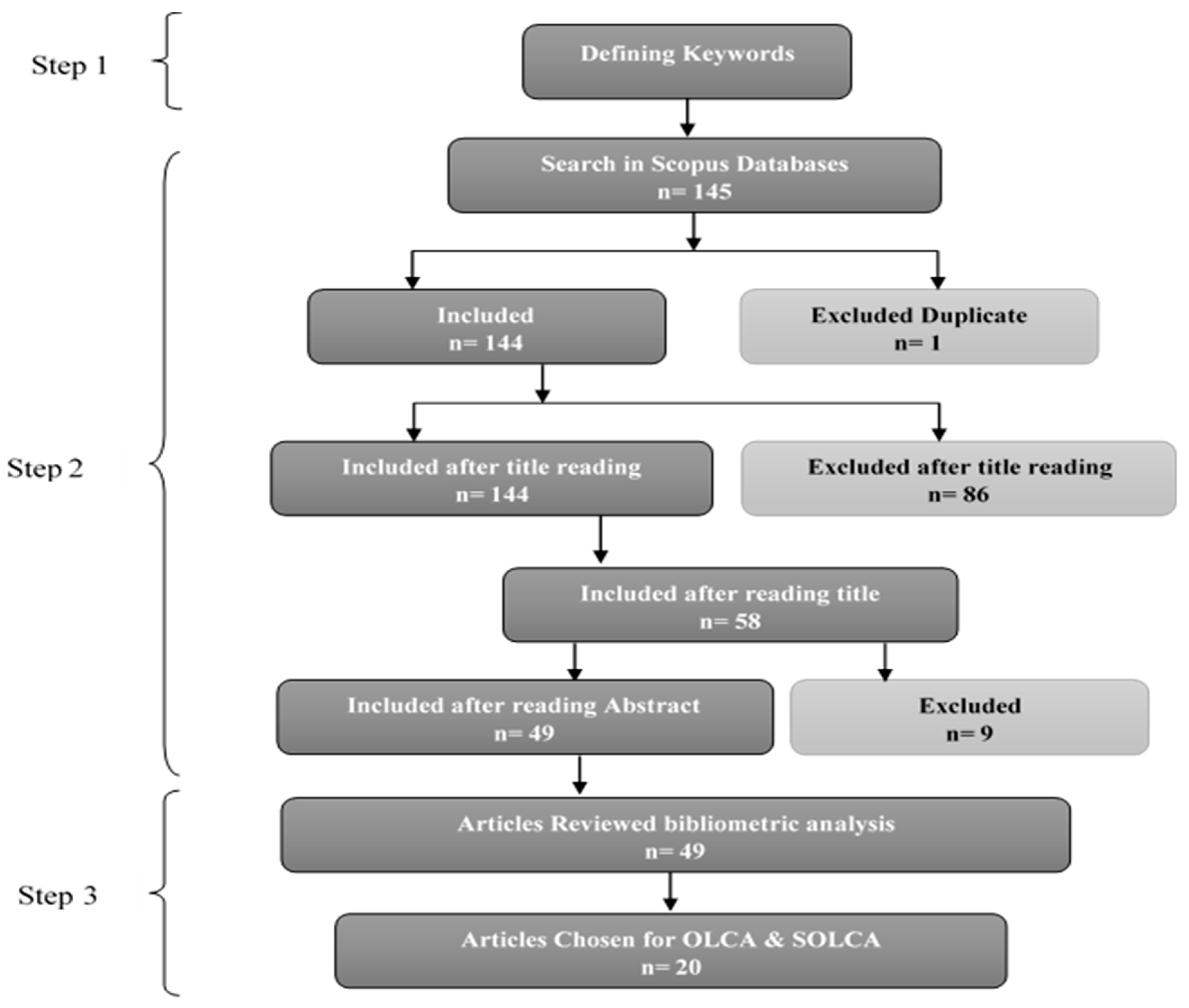
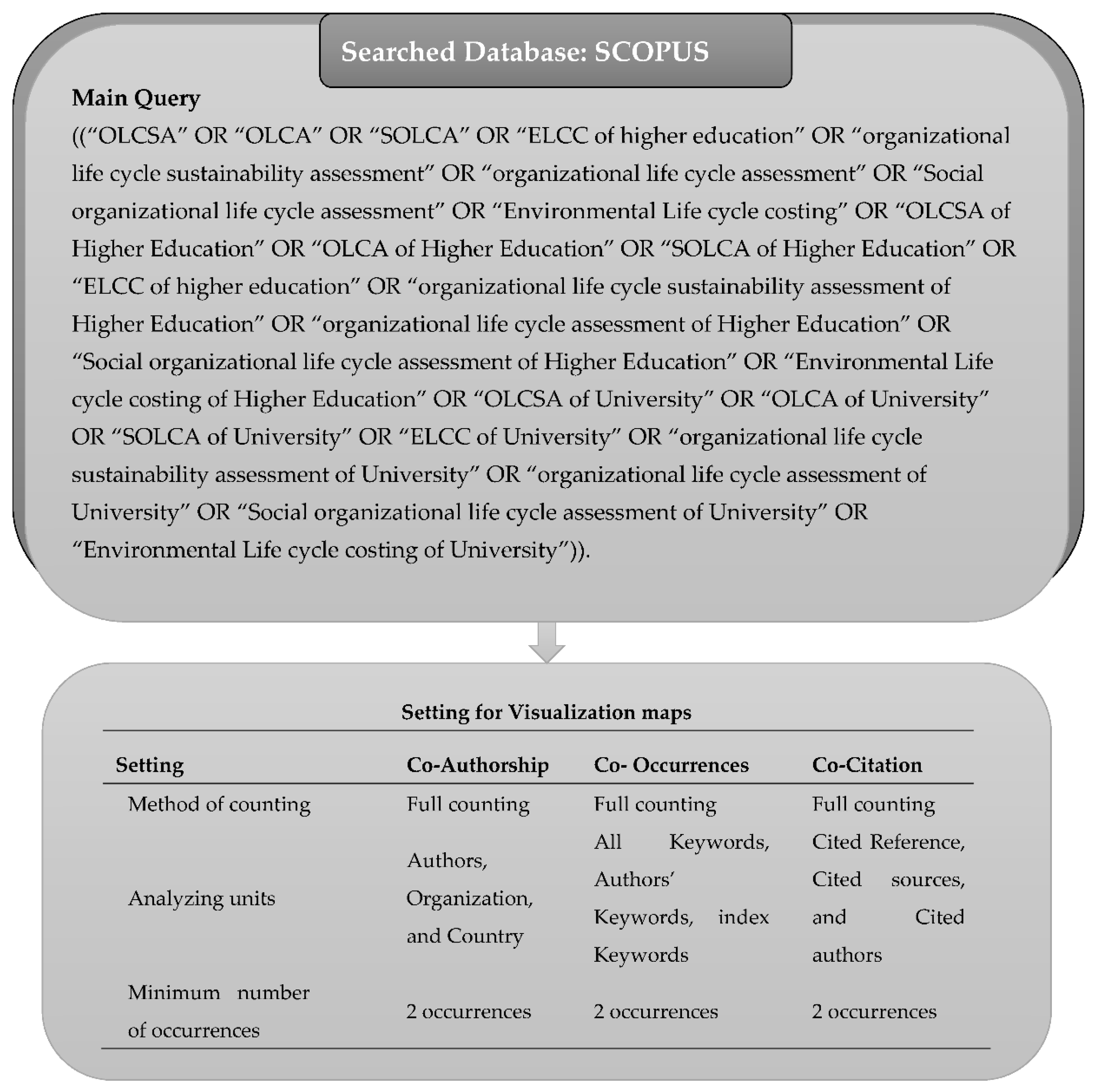
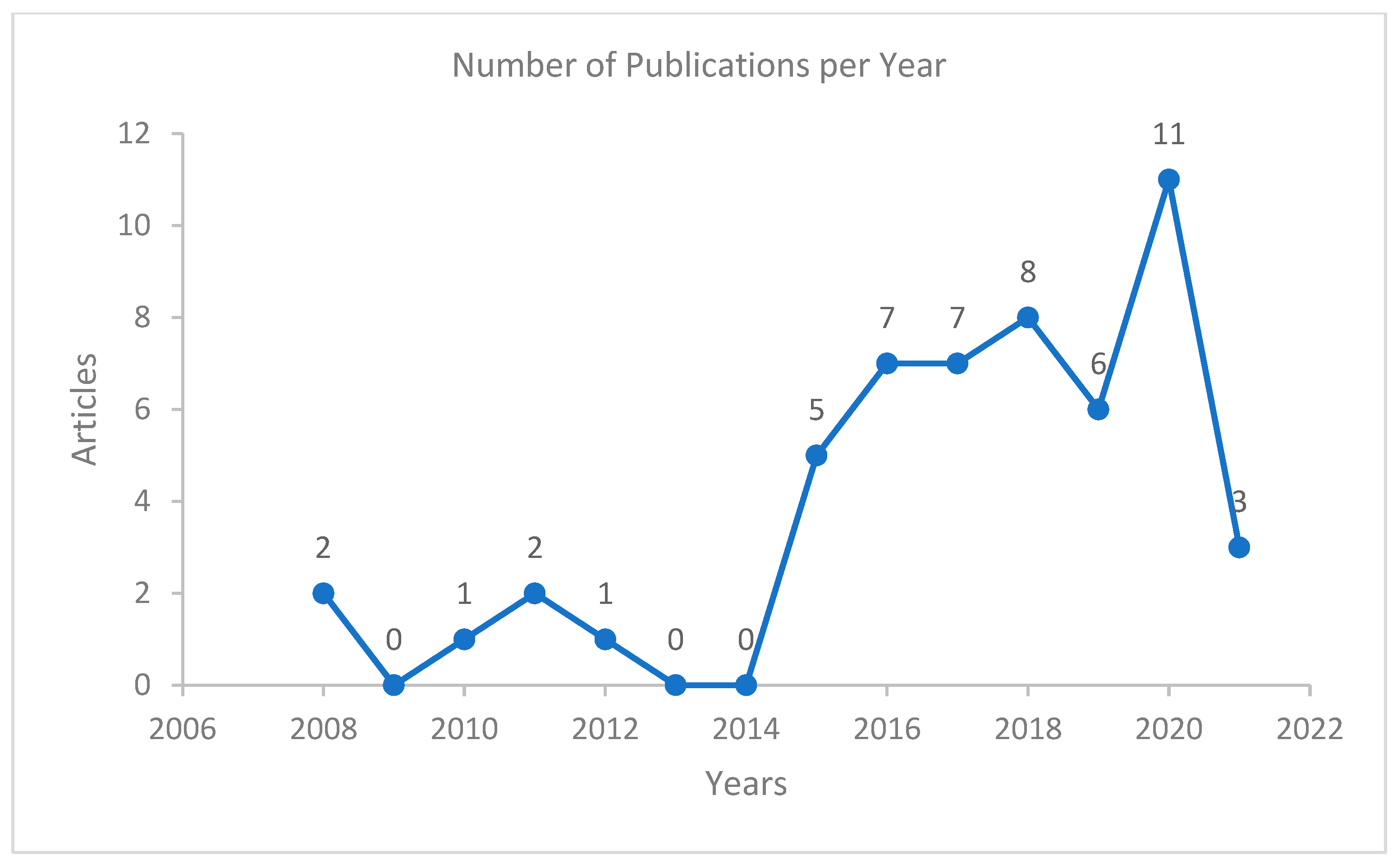
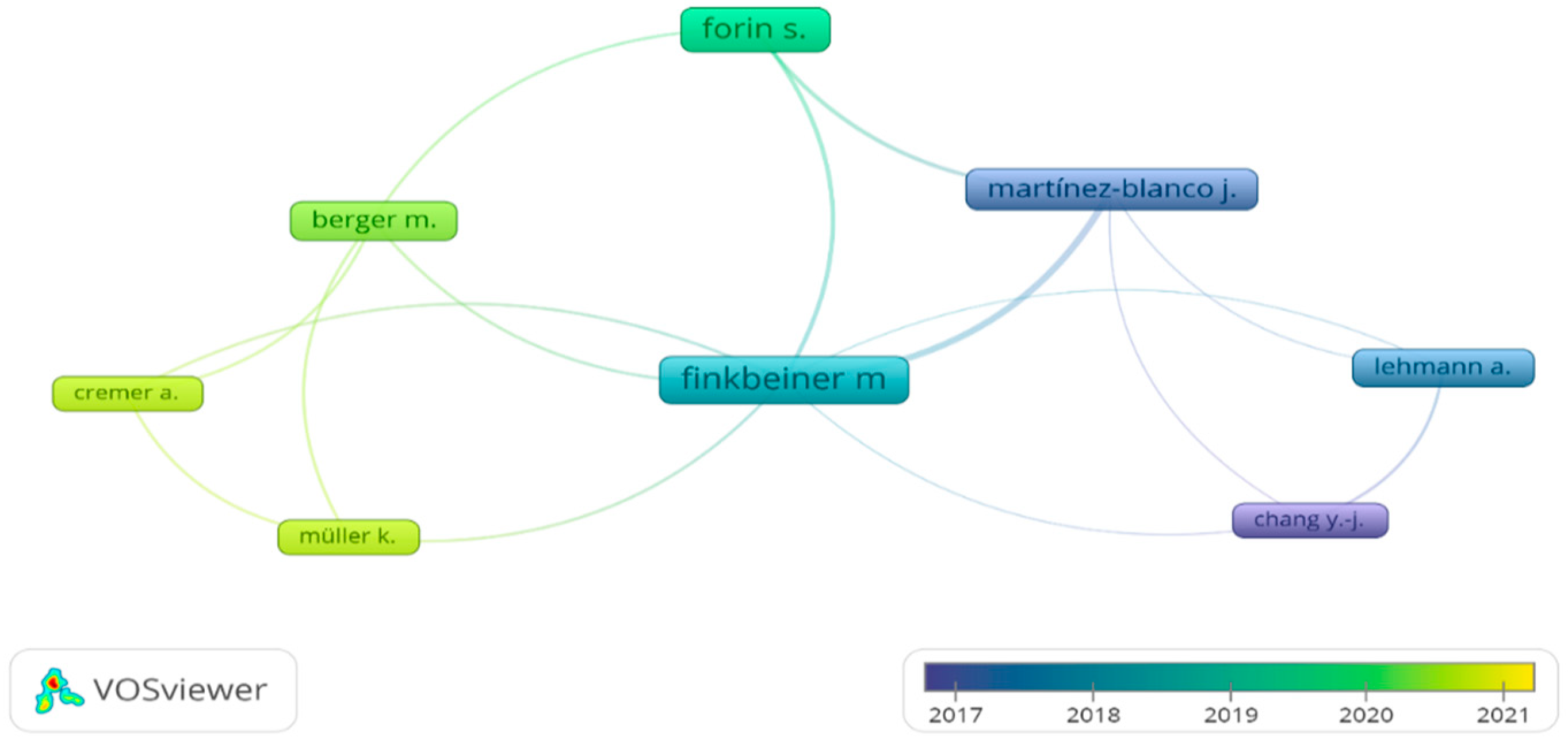
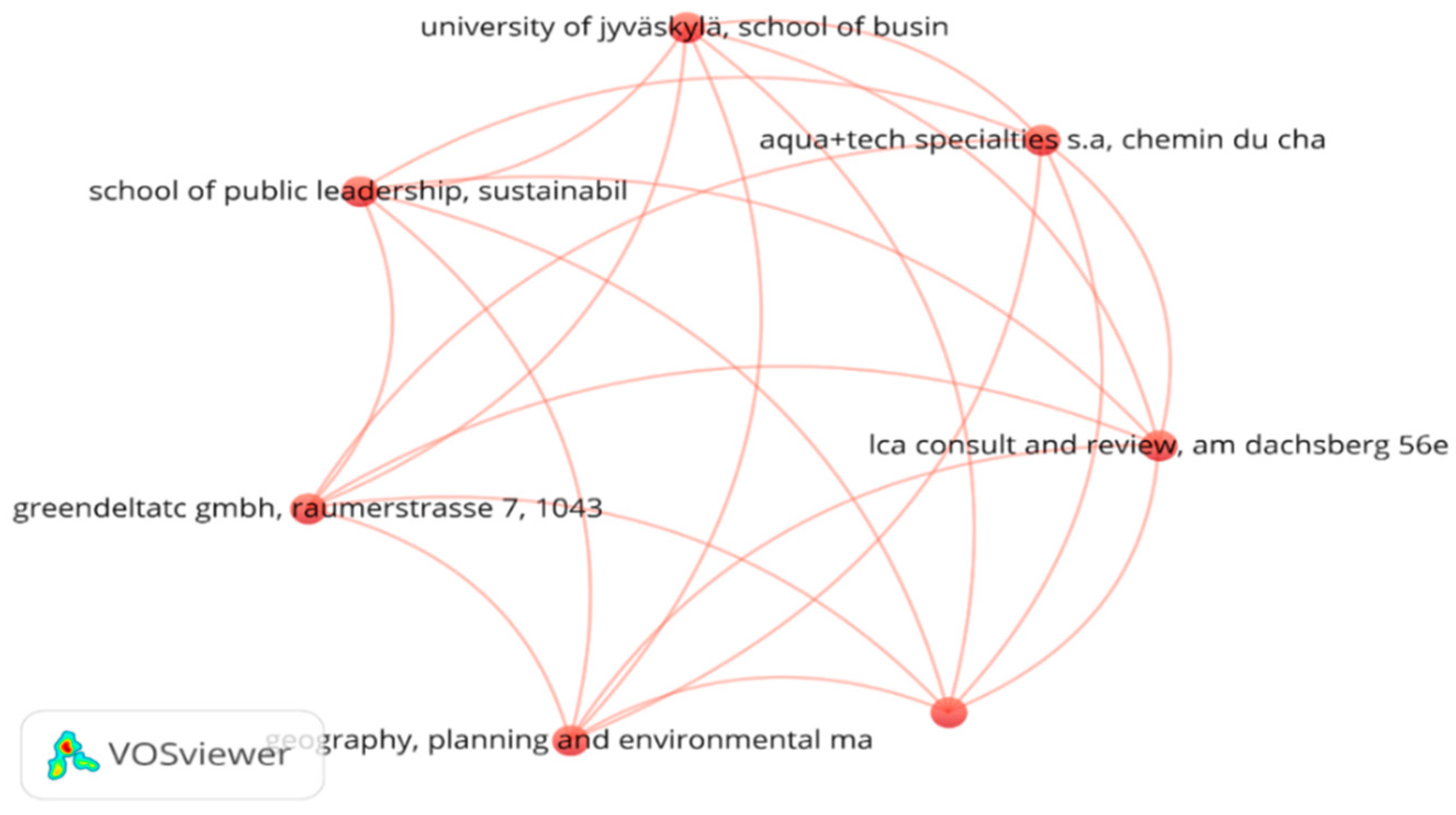
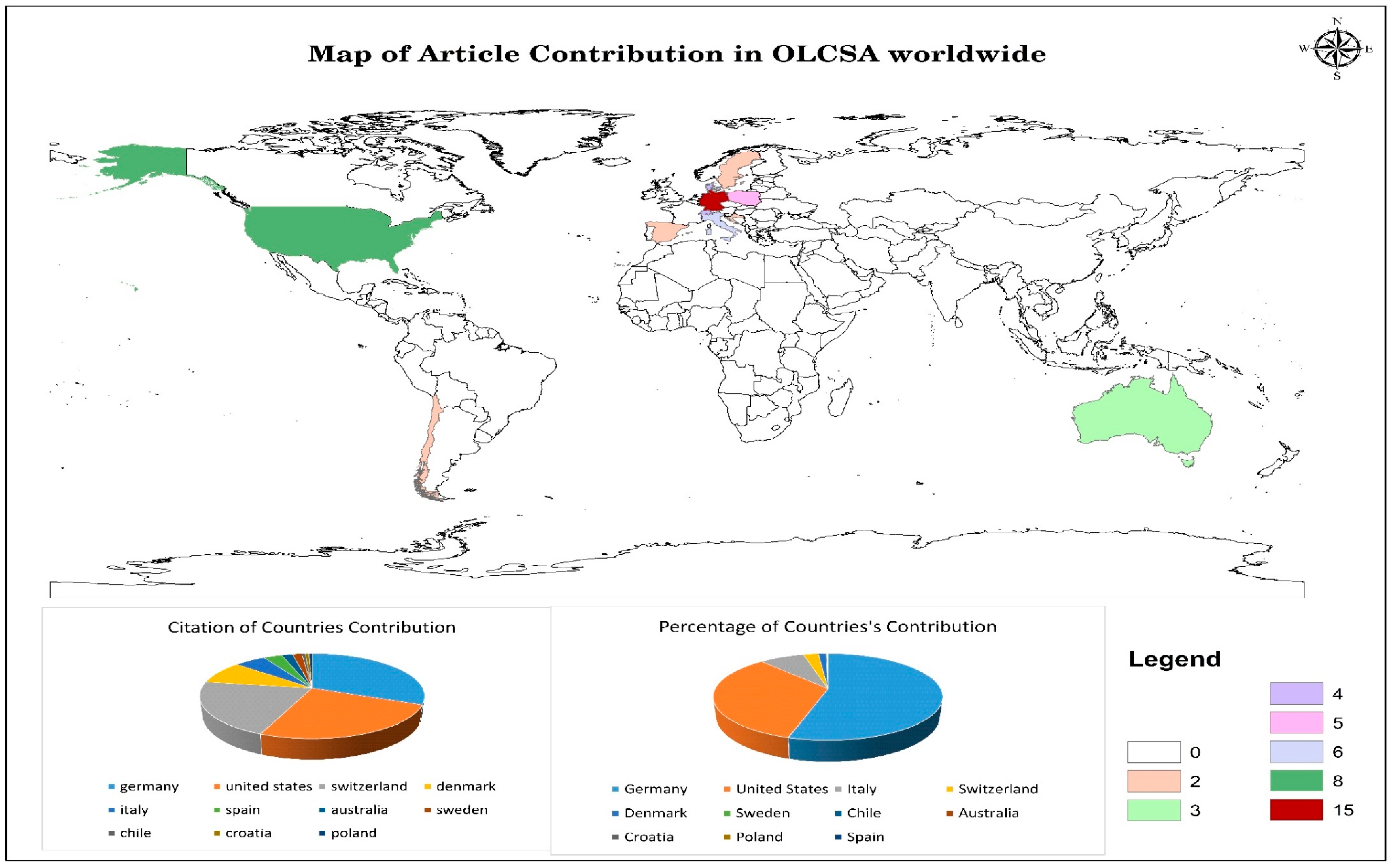
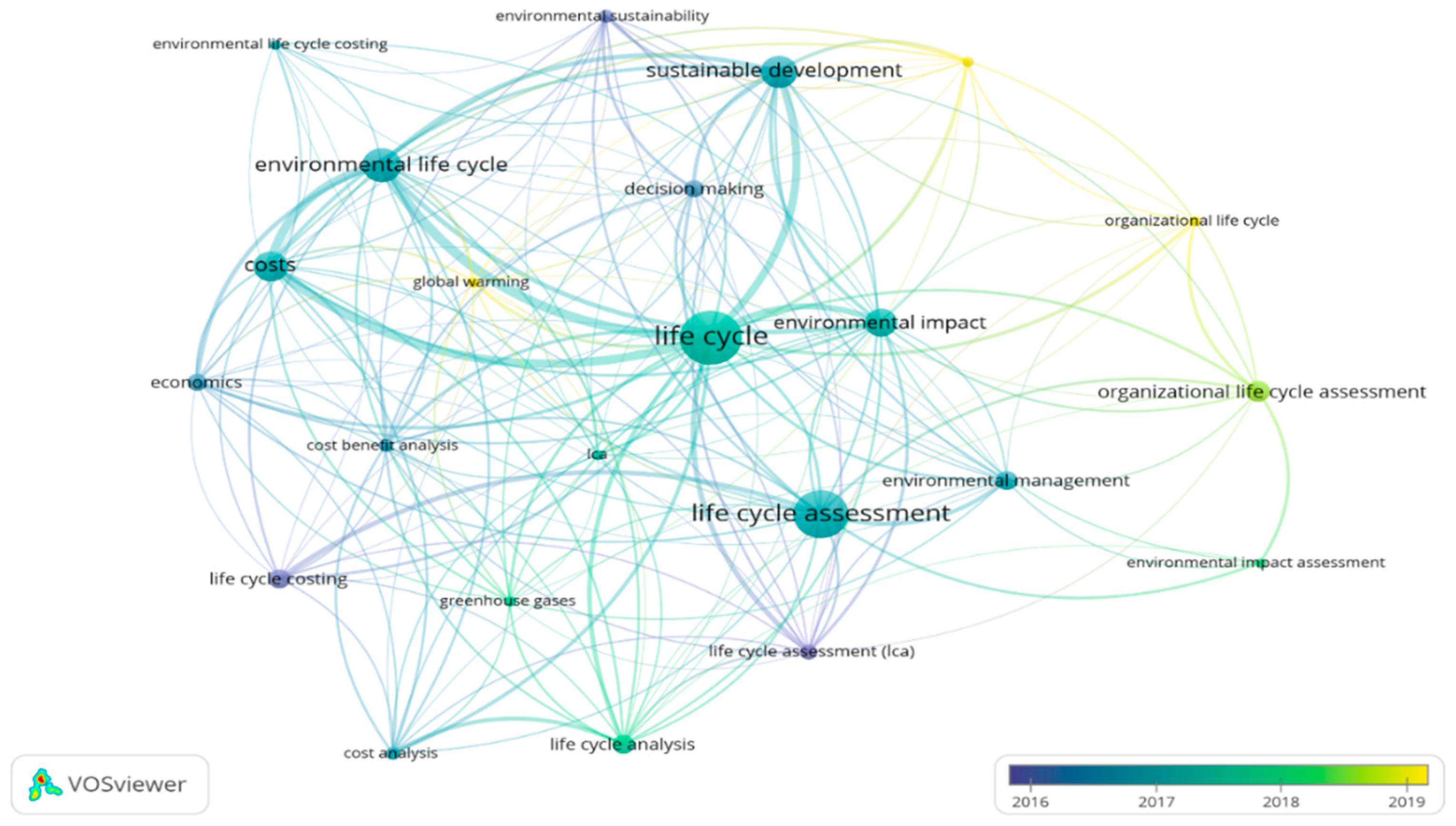
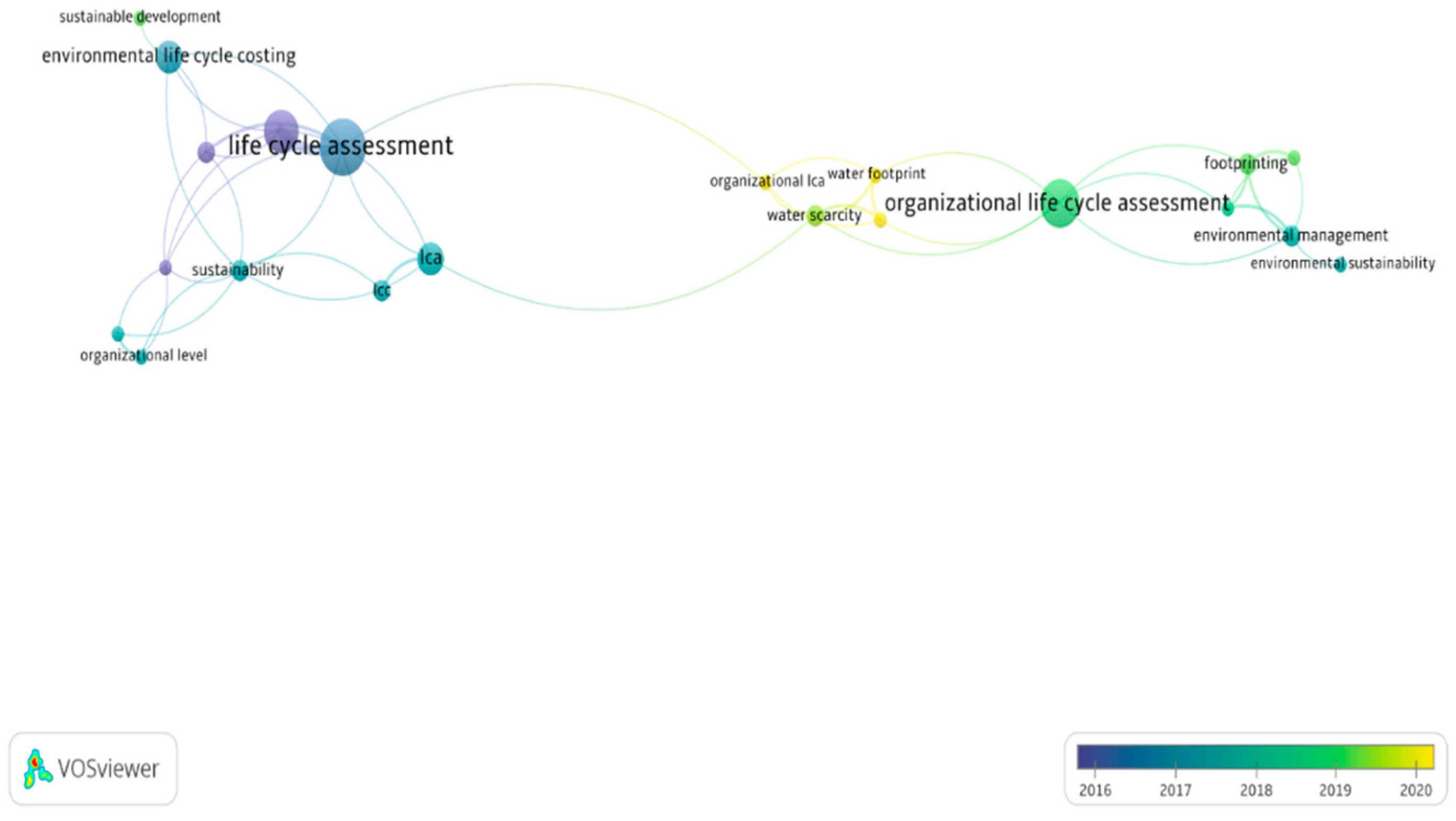
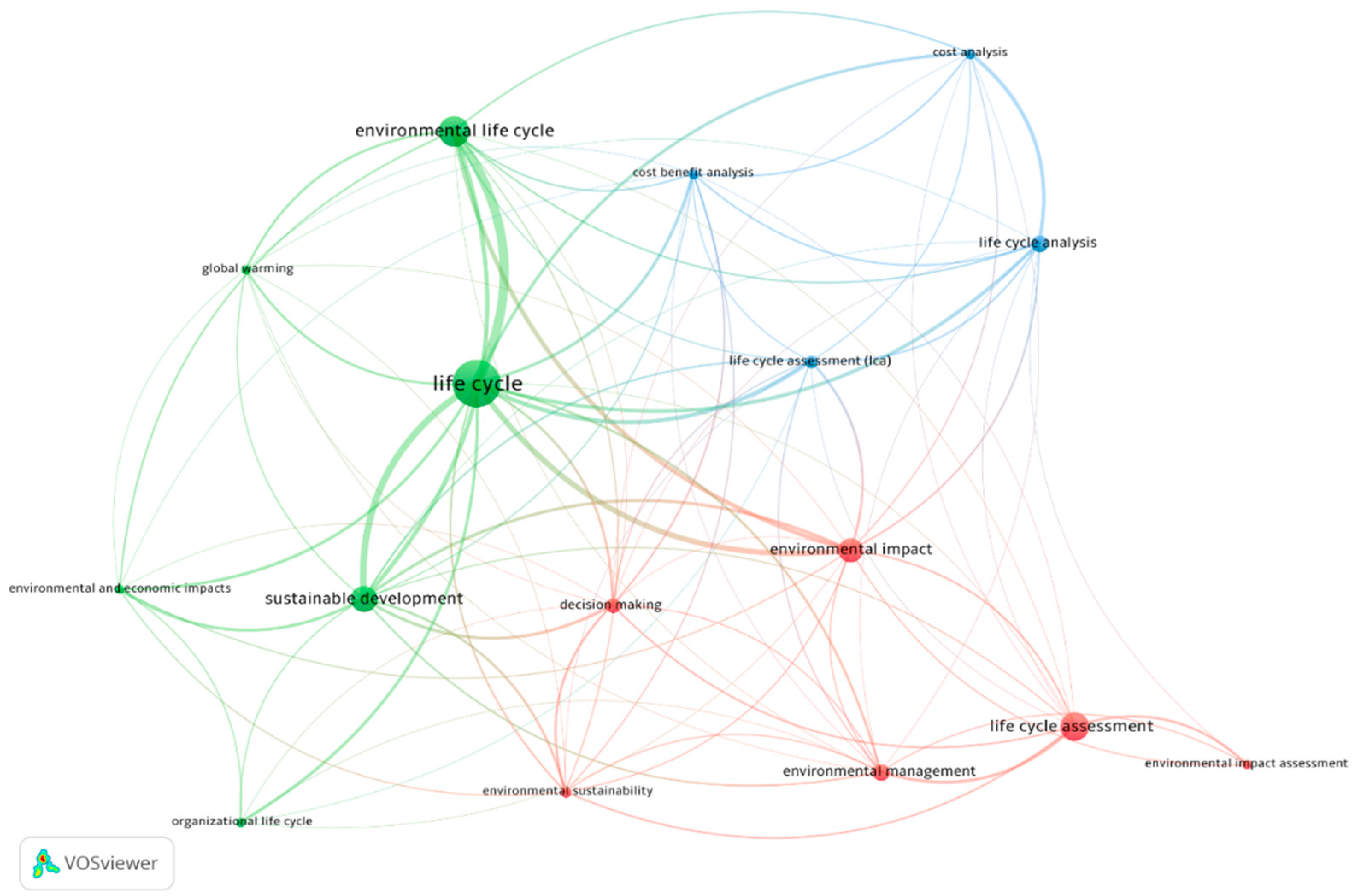
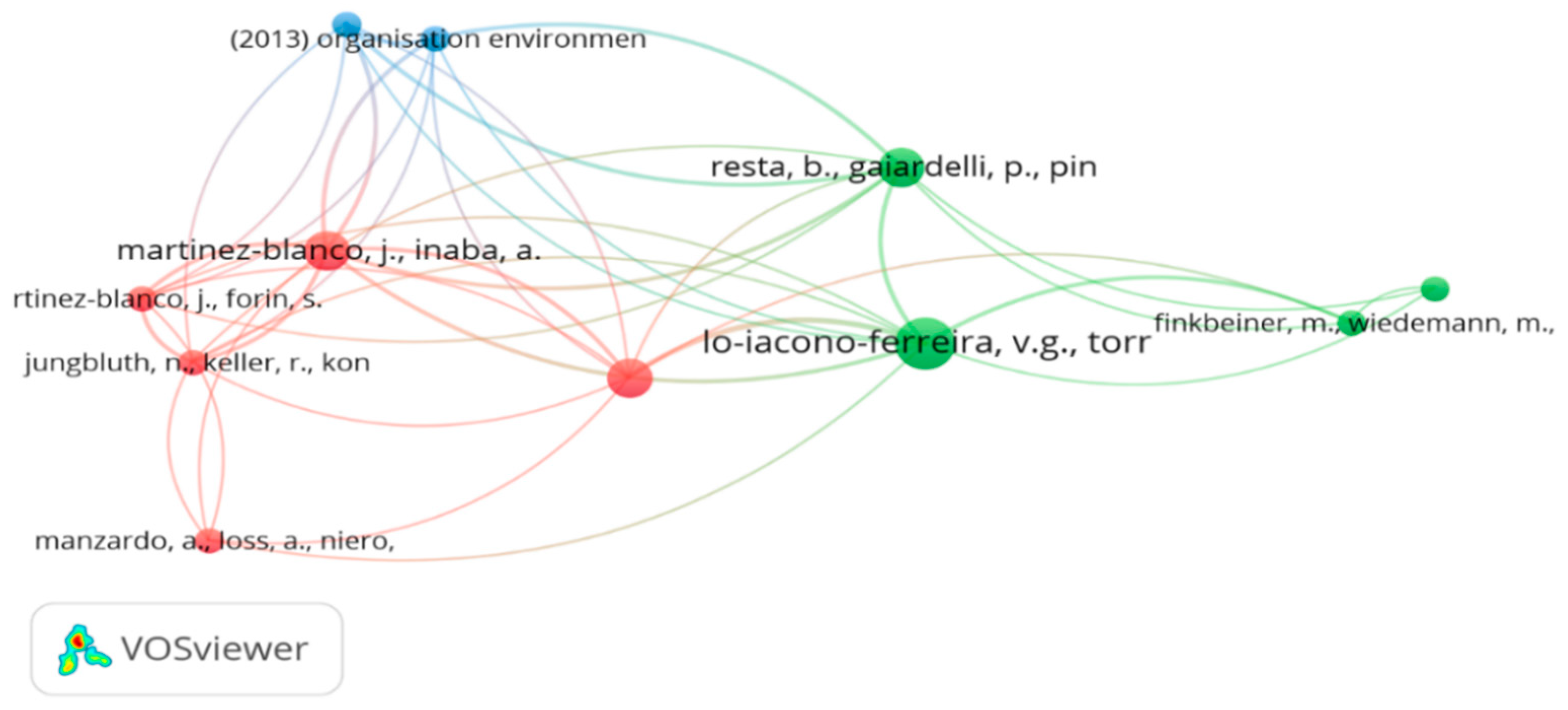

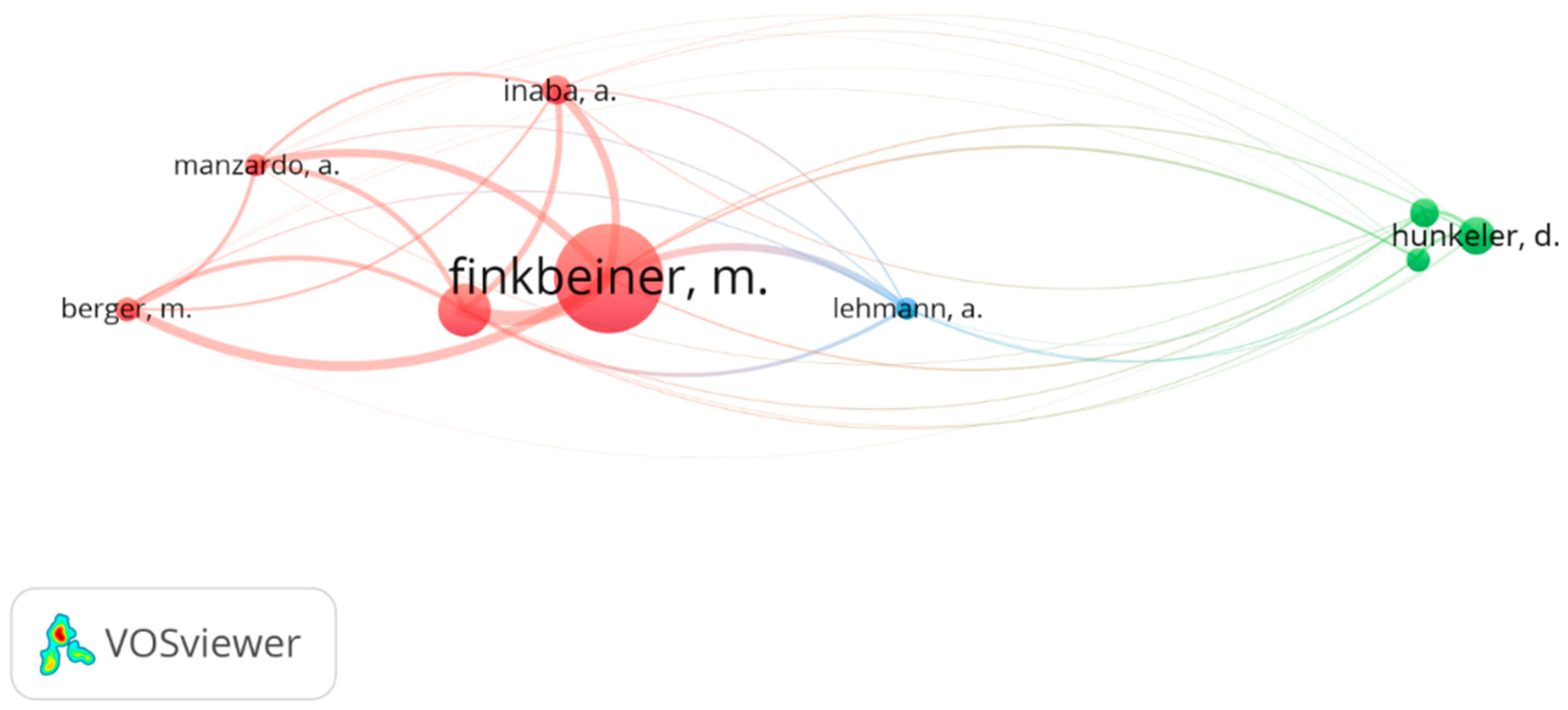
| Authors | Objective and Methods | Result and Conclusion |
|---|---|---|
| [28] | Objective: To test city O-LCA’s feasibility in a first case study with real city data from Vienna. | Result: The feasibility was confirmed, and results for 12 impact categories were obtained. |
| Method: To assess city O-LCA to the test in a first case study using real-world data from Vienna. | Conclusion: Incorporating an O-LCA methodology reveals environmental blind spots and prevents underestimating environmental costs. | |
| [29] | Objective: To manage organizational sustainability, either a restricted viewpoint or a lack of concepts and instruments to incorporate sustainability issues into day-to-day operations are limitations. | Result: The notion was implemented in an early software prototype, and its usability was tested. |
| Method: O-LCA guidelines. | Conclusion: The idea and prototype demonstrate the practicality and usefulness of an O-LCA-based management tool. | |
| [30] | Objective: To develop ecologically sustainable solutions while sticking to their responsibility to lay the groundwork for a successful society. | Result: O-LCA is well suited to evaluating potential environmental effects associated with local government provision of public services. |
| Method: a new methodology for city-scale LCA that broadens the existing methodological debate to include organizational LCA (O-LCA) | Conclusion: Assist local governments in measuring their operational practices, selecting mitigation strategies, and taking change initiatives into account in their strategic choices. | |
| [31] | Objective: Identifying and addressing their individual consequences and hotspots while avoiding burden shifting. | Result: The reporting organization’s environmental effect profile is dominated by transportation activities. |
| Method: In the United Kingdom, O-LCA was applied to a service-provider SME in the solar and wind energy industries. | Conclusion: Ways to reduce travel-related impacts are provided. | |
| [32] | Objective: The organizational water footprint approach implementing iso 14046 and ISO/TS 14072 allows for systematic collecting of the water footprint at the organizational level. | Result: Metals are key hotspots, especially when considering the local consequences of freshwater consumption caused by water scarcity, which primarily affects China and Chile. |
| Method: case study was carried out for Neoperl GmbH, a German company that offers innovative solutions regarding drinking water for the plumbing industry. | Conclusion: To improve the company’s supply chain water use in cooperation with internal and external stakeholders by means of, e.g., sustainable purchase strategies or eco-design options to substitute water-intensive materials. | |
| [33] | Objective: Water footprint at the organizational level. | Result: Comparisons between (i) system boundary definitions and (ii) ways to prevent allocation with conflicting or contradicting criteria were found. |
| Method: ISO 14046, dedicated to water footprint, and ISO/TS 14072 for organizational LCA (O-LCA) were compared. | Conclusion: The comparison of standards allows for the creation of a set of guidelines for organizational water footprints. | |
| [34] | Objective: To develop a life-cycle-based thinking and integrates OLCA modeling approach for Sustainable Business Process Management. | Result: The author has developed a web-based software prototype that exemplifies the idea of a POLCA modeling tool based on the above design principles. |
| Method: The two guiding principles are (1) business-process orientation and (2) life cycle perspective. | Conclusion: The formative assessment findings will then be used to drive a second development cycle, which will result in a beta version of the POLCA modeling tool. | |
| [35] | Objective: The study examines those obstacles to equip practitioners with lessons learned for future applications and assist future method development efforts. | Result: Specific additional concerns common to product LCA but amplified in organizational LCA were included in the paper’s focus is on challenges unique to the organizational approach. |
| Method: The focus of the paper is on challenges exclusive to the organizational approach; however, some additional issues common to product LCA but in organizational LCA were also included. | Conclusion: Further application testing is needed, along with research to support a future revision of the O-LCA guidance. | |
| [36] | Objective: To enable the method’s application, the guidance on OLCA was published within the UNEP/SETAC | Result: The survey revealed that most road tester prioritized analytical goals, which had a greater accomplishment rate than organizational and social goals, which required either long-term measurements or stakeholder participation. |
| Method: Anonymous survey about the method application was directed among the road testers. | Conclusion: The road-testing organizations verified the applicability and practicality of the O-LCA guidance. | |
| [37] | Objective: To establish a tourist hamlet in Italy specific purpose, in line with OLCA. | Result: The application of the proposed methodological ideas to unique purpose entities in the construction industry was demonstrated, and the fact that OLCA results can be compared to product-based life cycle assessment results. |
| Method: Requirements of ISO/TS 14072 and consider the guidelines published by the UNEP. | Conclusion: The OLCA methodology could barely be applied to the construction industry. | |
| [5] | Objective: To review the flagship project phases and main consequences. | Result: The positive results of the road testing have revealed that no immediate revisions to the O-LCA guidance are required, but several priority measures have been noted to ease the use of O-LCA. |
| Method: The “Guidance on OLCA” was published. During the following two years, the flagship project accompanied 12 organizations in the road testing of O-LCA guidance. | Conclusion: Three tasks identified: firstly, the challenges underlined during the road testing should be addressed in the future by the LCA community; specific methodological should be targeted; and finally, the potential revealed by the organizational perspective can be arrayed in adjacent LCA fields | |
| [1] | Objective: A multisite beverage business conducted an organizational life cycle assessment (OLCA) as well as a product LCA on one of its representative beverage products. | Result: a specific beverage product among different sites could improve product environmental performance while deteriorating overall organizational environmental performance. |
| Method: A comparison of OLCA and LCA. | Conclusion: It is critical to consider production allocation strategies to avoid environmental burden shifting when using LCA and OLCA results to improve its environmental performance. | |
| [6] | Objective: To analyze the suitability of O-LCAs for higher education institutions (HEIs). | Result: The GHG system’s three scope scheme is combined with the ISO 14072 boundary definition to better align with the HEI structure. Unfortunately, due to a lack of quality data, LCIA can only be assessed partially. |
| Method: ISO/TS 14072 and UNEP guidance were carried out using the Universitat Politècnica de València (UPV) EMS verified by the EMAS. | Conclusion: An EMS verified by EMAS is proven to be valued in assessing O-LCA for HEIs. | |
| [38] | Objective: To identify production systems of beef cattle that allow reducing the greenhouse gas emissions. | Result: The best results in terms of profitability and emissions, reducing emissions per kg of live weight by 45% and increasing profitability per hectare by 38%. |
| Method: ELCC methodology was utilized, which included environmental LCA and investment analysis methods. | Conclusion: To increase the stocking rate per hectare and the average daily gain per animal, pasture improvements are required. | |
| [39] | Objective: To highlight the most important difficulties in the use of organizational life-cycle assessment for the packaging industry. | Result: Packaging companies have shown a keen interest in environmental management and improvement techniques, including LCA. |
| Method: ISO/TS 14072. | Conclusion: Despite the growing interest in this subject and essential experiences, no relevant applications have been published in the packaging industry. | |
| [40] | Objective: To use OLCA as decision-making textile industry. | Result: A tool was created for each step of the Organizational Life Cycle Assessment. The tools were created after extensive research and semi-structured interviews at six textile businesses. |
| Method: OLCA. | Conclusion: Direct observation (plant tours) was also utilized to gather data. Uncover the advantages of this decision-making process by studying a spinning organization. | |
| [41] | Objective: To introduce ISO/TS 14072, developed by several initiatives. | Result: This article exposes academics and practitioners to the O-LCA methodological framework, with a special emphasis on the scoping step. |
| Method: The resulting methodology was the so-called organizational LCA (O-LCA), introduced by ISO/TS 14072 and developed by several initiatives. | Conclusion: Although LCA was originally designed for products, it may also be used to organizations. | |
| [42] | Objective: An organization life cycle assessment (OLCA) approach for the textile industry’s new decision-making process was suggested. | Result: The advantages of this decision-making process are shown via a case study of a spinning company. |
| Method: OLCA, the study of literature and in-depth semi-structural interviews in six textile businesses. | Conclusion: O-LCA technique is designed to assist operations managers in making informed decisions regarding the environmental impact of their activities. |
| Authors | Objective and Methods | Result and Conclusion |
|---|---|---|
| [14] | Objective: A method for identifying and incorporating the critical social issues of a sector or organization into the social organizational life cycle assessment framework. | Result: The findings allowed the most relevant subcategories for the case under investigation to be identified. |
| Method: The Pugh matrix considered the subcategories, i.e., social issues, and the stakeholder categories proposed by the guidelines for Social LCA UNEP/SETAC. | Conclusion: This study executes and implements a model within the SO-LCA framework, as well as S-LCA, in order to support decision-makers, taking into account the entire value chain over time. | |
| [12] | Objective: To lay the ground for the progress, improvement, and dissemination of a lifecycle-based social assessment. | Result: Existing S-LCA case studies do not assess a product’s social impact. Only eight of the 189 suggested S-LCA indicators relate to products with overlaps and methodological sheets, whereas 127 relate to organizations and 69 to nations. This finding supports a group based social LCA strategy. |
| Method: Two underlying methodologies, the guidelines for SLCA of products and the guidance on O-LCA, were used. | Conclusion: The frameworks of S-LCA and O-LCA can be integrated into SO-LCA, and existing experience from organizations can be used for implementing it. |
| Authors | Objective and Methods | Result and Conclusion |
|---|---|---|
| [43] | Objective: To explore the life cycle economic performance of the PCE2 system. | Result: The research used a future environmental LCC from a building owner/viewpoint consumer to investigate early cost optimization methods for the VEEP PCE2 system in the Netherlands. |
| Method: Case study which employed environmental life cycle costing (LCC). | Conclusion: Reveals significant cost consequences for resource-efficient building energy refurbishment in Europe and methodological issues with LCC. | |
| [44] | Objective: Upgrading anaerobic digestion biogas from municipal solid waste organic fraction to high-grade biomethane. | Result: All the examined options are fully sustainable. |
| Method: Study review using ELCC. | Conclusion: The studied methods’ performances seem to be reliant on site-specific circumstances and market-specific strategies. | |
| [45] | Objective: to integrate life cycle assessment with environmental life cycle costing, in the context of food waste. | Result: An analytical framework and a set of suggestions were created to address various assessment scenarios. |
| Method: A study of the literature was conducted to ascertain pertinent methodological issues. | Conclusion: Fostering informed private and public decision-making and even more effective food supply networks. | |
| [46] | Objective: To develop a conceptual framework based on the approach to build an intelligent system for E-LCC computations. | Result: The E-LCC calculation technique has to be unified via an integrated information system. |
| Method: E-LCC calculations. | Conclusion: Demonstrated comparisons of E-LCCs for various goods or services. | |
| [47] | Objective: To assess maritime operations contribute substantially to global warming and air pollution based on ELCC | Result: LCC is often used to measure the monetary worth of certain expenses. |
| Method: E-LCC | Conclusion: Clean and energy-efficient transport is initially more expensive. | |
| [48] | Objective: To examine the environmental and economic sustainability of construction materials in unpredictable geopolitical environments. | Result: Trade-offs and the degree to which effects vary according to the substance under consideration. |
| Method: Using an LCC method. | Conclusion: To reduce environmental and economic effects, nations experiencing geopolitical instability must evaluate alternate routes’ sustainability potential. | |
| [49] | Objective: To determine the costs of municipal residual waste processing in Italy. | Result: Delivered 1 ton of residual trash sent into the MBT plant, and 1 MWh of exergy generated by the MBT plant’s energy valorization of the streams. |
| Method: The environmental life cycle costing (LCC) methodology. | Conclusion: The findings seem to strongly suggest treating RW in a single stream MBT plant and producing an SRF with properties appropriate for burning, replacing fossil fuel. | |
| [50] | Objective: To include social and environmental costs in the price of goods. | Result: The sustainability price of a t-shirt produced in India is only about 2% more than the existing price when retailed in the USA. |
| Method: Case study. | Conclusion: The Sustainability Price communicates the costs to address poverty and climate change in global supply chains. | |
| [51] | Objective: To identify the most cost-effective method for attaining environmental sustainability in power generation. | Result: All alternative energy scenarios demonstrated a 47–92% reduction in global warming, a 46–90% reduction in human health, and a 47–91% reduction in ecological effects. |
| Method: Three biomass-based alternative scenarios were compared using an environmental life cycle costing methodology. | Conclusion: Bioenergy has the potential to assist in the transition and transformation of coal-fired power plants to more sustainable forms of energy generation. | |
| [19] | Objective: To discover environmental life cycle costing in network organizations. | Result: Identified network organization business processes and recognized network organization features to improve ELCC calculations. |
| Method: E-LCC. | Conclusion: The collected findings may be utilized to compute E-LCC automatically using artificial intelligence techniques, for example. | |
| [52] | Objective: To identify current E-LCC implementation obstacles in manufacturing businesses. | Result: The formulation of new hypotheses. |
| Method: Questionnaire. | Conclusion: Shorter product life cycles are a hindrance to adopting E-LCC. | |
| [53] | Objective: To explore the relationship between E-LCC and sustainability. | Result: Social acceptability of recycled water and market access for resources posed a significant risk to investment. |
| Method: Two detailed wastewater case studies. | Conclusion: Identifying these principles may also assist in clarifying E-LCC’s function and in assessing sustainability across the life cycle. | |
| [54] | Objective: To show the relationship between the various kinds of economic activity and the environmental life cycle costing implementation. | Result: The key findings permit new hypotheses. |
| Method: A questionnaire interview. | Conclusion: (1) the selected methods of identifying product life cycle stages depend on enterprise size; (2) preparation of controlling departments as to the subject matter determines the selection of a method of identifying product life cycle stages; and (3) shorter product life cycles determine the applied method of identifying life cycle stages. | |
| [18] | Objective: To develop a streamlined E-LCC model for buildings. | Result: There are ten main building materials that account for more than 95% of overall direct construction cost. |
| Method: Conducted a case study to empirically verify the applicability of the proposed model. | Conclusion: Environmental and economic performance of a building are evaluated simultaneously and integrated early in the planning stage. | |
| [55] | Objective: To identify the most cost-effective method for attaining environmental sustainability in power production. | Result: All alternative energy scenarios demonstrated an improvement in the environmental life cycle. |
| Method: An environmental life cycle costing approach. | Conclusion: Bioenergy can support coal power plants’ shift to more sustainable electricity generation. | |
| [56] | Objective: To propose the framework for assessment of the integral impact on the environment which combines E-LCC approach with TBL concept. | Result: The environmental LCC method takes into account the external environmental costs alongside whole costs, which are calculate conventionally. |
| Method: The environmental effect of marine shipping was assessed. | Conclusion: Environmental concerns must be included in contract award processes when public procurement is used as a policy approach tool. | |
| [57] | Objective: To introduce LCC and its use un support decision making. | Result: Inventory data are often sensitive in financial studies; a list of relevant databases is given, along with instructions on gathering data to overcome this obstacle. |
| Method: Defining concepts, principles, and prices. The major cost categories to consider from various user viewpoints are described and handled. | Conclusion: Advanced LCC techniques for monetarizing externalities and discounting are presented. | |
| [58] | Objective: To improve integrated life cycle assessment (LCA) and life cycle costing methodologies (LCCs). | Result: The hybridized framework is unique in that it attempts to offer decision-makers a complete approach for navigating environmental and economic analyses. |
| Method: For the first time, a hybridized framework combines environmental and economic research for decision-makers. | Conclusion: The hybridized framework may be used to assess, enhance, and manage the environmental and economic sustainability of goods, technologies, and systems. | |
| [59] | Objective: To analyze the use of E-LCC to the assessment of the sustainability of technologies. | Result: A technology’s environmental life cycle cost may be used to evaluate its economic and environmental impacts in one monetary value. |
| Method: E-LCC review. | Conclusion: E-LCC is one of the most useful tools to assess the technologies. | |
| [60] | Objective: To study the LCA and E-LCC of lignocellulosic bioethanol mixes with gasoline (CG). | Result: Compared to CG, E85 seems to be the superb option for reducing GHG emissions and lowering fuel production costs. |
| Method: To evaluate the environmental and economic benefits of the chosen fuel mixes. | Conclusion: Shifting from gasoline to bioethanol increases the emissions that contribute to eutrophication and photochemical ozone depletion. | |
| [61] | Objective: To put focus on the EIA of three different high-efficiency residential pellet boilers. | Result: Replacing outdated biomass boilers with high-efficiency pellet boilers may enhance the air quality in regions of the EU Conclusion: No significant differences in air quality were evidenced for NO2 concentrations. |
| Method: The SimaPro software was used for the LCA and E-LCC analysis. | ||
| [62] | Objective: To compare one food waste management method against others, such as conversion to animal feed or energy. | Result: Income impacts are unpredictable; they should be considered in all scenarios. |
| Method: In this study, we used societal life-cycle costing. | Conclusion: It emphasizes the need of food avoidance methods that not only discourage the purchase of uneaten food but also encourage low-impact usage of the savings gained. | |
| [63] | Objective: To investigate the use of full ELCC methodology to evaluate the economic performance of a 50 MW parabolic through concentrated solar power (CSP). | Result: This approach results in lower revenues and lowers net present value (of the project) due to greater internal expenses. |
| Method: E-LCC. | Conclusion: Solar-only operation remains the best option. | |
| [64] | Objective: To estimate the entire cost of typically large-scale assets. | Result: When combining life cycle evaluation (LCA) and environmental LCA in one assessment, ELCC was developed to be linked with the ISO 14040 standard for a life cycle assessment (LCA). |
| Method: A case study for a combined heat and power plant was used to illustrate the application of environmental LCC. | Conclusion: In the case of renewables, feed-in tariffs and subsidies must be addressed. | |
| [65] | Objective: To improve the LCC common matrix-based method. | Result: The findings indicate that LCC definition and computational structure can be completely harmonized with LCAs. The vector of additional values may be used for distributional analysis as well as eco-efficiency estimates. |
| Method: The authors derive the LCC from both physical and monetary technology matrices by employing a simple and fictional scenario. | Conclusion: The authors reduced LCC calculation using a matrices-based method or upstream activity, adding values as a basic exchange vector or matrix. | |
| [66] | Objective: To review the use of economic values in LCA and the justification for E-LCC. | Result: Over the last two decades, LCA is dominated by a utilitarian philosophy and a willingness to pay value. The decision-maker may establish ideals that are incompatible with sustainability. |
| Method: A transdisciplinary review of economic values in LCA was undertaken. | Conclusion: This study questioned LCA’s utilitarianism and willingness to pay value, and in particular, E-LCC’s claim to be the economic pillar of LCSA. | |
| [67] | Objective: To present the results of a product’s sustainability evaluation. | Result: The traditional iron-cast alternator outperforms the lighter aluminum alternators in LCA and LCC. |
| Method: (ISO) (14040 and 14044). | Conclusion: Sustainability is becoming an increasingly important factor in global competitiveness. | |
| [68] | Objective: To offer a code of practice for LCC that provides a structure for making choices in a consistent manner. | Result: LCC predated LCA, and its developmental origins may be traced via diverse and different philosophical underpinnings and methodological methods. |
| Method: The LCC code of practice. | Conclusion: The code of practice is an essential first step in defining a rigorous methodology for LCC. | |
| [69] | Objective: The environmental LCC is described, with a particular emphasis on critical aspects to address before to and throughout the assessment. | Result: It is suggested that the findings be interpreted and that portfolio displays of LCC as a function of the primary environmental effect be used. |
| Method: The Society of Environmental Toxicology and Chemistry (SETAC) was discussed. | Conclusion: Input–output LCC is discussed and applied to the cross-cutting washing machine example. |
Publisher’s Note: MDPI stays neutral with regard to jurisdictional claims in published maps and institutional affiliations. |
© 2022 by the authors. Licensee MDPI, Basel, Switzerland. This article is an open access article distributed under the terms and conditions of the Creative Commons Attribution (CC BY) license (https://creativecommons.org/licenses/by/4.0/).
Share and Cite
Wafa, W.; Sharaai, A.H.; Matthew, N.K.; Ho, S.A.J.; Akhundzada, N.A. Organizational Life Cycle Sustainability Assessment (OLCSA) for a Higher Education Institution as an Organization: A Systematic Review and Bibliometric Analysis. Sustainability 2022, 14, 2616. https://doi.org/10.3390/su14052616
Wafa W, Sharaai AH, Matthew NK, Ho SAJ, Akhundzada NA. Organizational Life Cycle Sustainability Assessment (OLCSA) for a Higher Education Institution as an Organization: A Systematic Review and Bibliometric Analysis. Sustainability. 2022; 14(5):2616. https://doi.org/10.3390/su14052616
Chicago/Turabian StyleWafa, Wafaurahman, Amir Hamzah Sharaai, Nitanan Koshy Matthew, Sabrina Abdullah J Ho, and Noor Ahmad Akhundzada. 2022. "Organizational Life Cycle Sustainability Assessment (OLCSA) for a Higher Education Institution as an Organization: A Systematic Review and Bibliometric Analysis" Sustainability 14, no. 5: 2616. https://doi.org/10.3390/su14052616
APA StyleWafa, W., Sharaai, A. H., Matthew, N. K., Ho, S. A. J., & Akhundzada, N. A. (2022). Organizational Life Cycle Sustainability Assessment (OLCSA) for a Higher Education Institution as an Organization: A Systematic Review and Bibliometric Analysis. Sustainability, 14(5), 2616. https://doi.org/10.3390/su14052616









